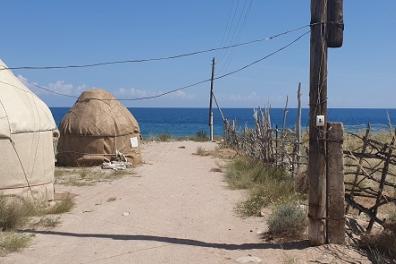Portrait of Océane Meena Lleida: immersion student in Kyrgyzstan

Océane Meena Lleida, recipient of an immersion scholarship to Kyrgyzstan, talks in this portrait about what led her to take an interest in this Central Asian region, her academic background and the focus of her research there. This interview is also an opportunity for her to tell us about her ambitions and plans for the future.
Could you introduce yourself and your academic background?
My name is Océane Meena Lleida and I've been a student at Inalco since 2018. I was born in France to parents of Afghan origin. I started with an LLCER in Hindi, then broadened my knowledge by doing a license in International Relations, an LLCER in Persian, and now, an LLCER in Turkishology. I also took courses in linguistics and rare and ancient languages at ILARA - EPHE (avestics, linguistics of Turkic languages, Sanskrit, classical Mongolian...), and did the first semester of the Mongolian bachelor's degree at Inalco, before moving to Tajikistan. I stayed in Tajikistan for six months, then moved to Kyrgyzstan, where I now live. Living in the region where I do my studies and research means I can learn much faster and have direct access to the information I need. Personally, I'm really happy to live here and I feel fulfilled.
Could you introduce us to the subject of your research?
Historically, Turkic and Iranian peoples have more or less always been in contact, at least since the great waves of Turkic displacement from Siberia to Central Asia, and naturally, this affects many fields, including language.
There have been many loanwords, but also grammatical and syntactic influences between Turkic and Iranian languages. There are a few studies on this subject on the Turkic languages of Anatolia and the Caucasus (Turkish, Azeri etc.), but few in the case of languages such as Kyrgyz, Tajik etc. However, there are many borrowings, and they are all the more interesting as they correspond to specific contact dynamics between these groups. For example, there are many Turkic loanwords in Persian that enter the lexicon of metallurgy. And yet, metallurgy has long been considered a favorite domain of Turkic nomads. On the other hand, there are more or less borrowings depending on the geographical area and therefore on the dialect. For example, Tajik from Khujand presents many borrowings, which are not present in other dialects.
It's all these aspects that I study, which requires learning these languages, paying attention to the different dialects and parlers, as well as to the etymologies of terms, and the signs that can indicate the origin of a word in its structure.
How did you come to choose this subject?
I thought I wanted to devote my research and future career to anthropology, but every time I discovered an exciting subject to study, it was always in connection with the fields of linguistics, philology, linguistic anthropology or even socio-linguistics. So I decided to devote myself to languages and related subjects, and allowed myself to spend more time studying Central Asian languages (especially Tajik and Kyrgyz at the moment). The fact that I'm interested in Turkic languages, Iranian languages and Indo-Aryan languages (a sub-branch of the Indo-European languages of the Indian subcontinent) at the same time allows me to see the meeting points, exchanges and influences of one on the other, and in the light of the history of these two regions (Central Asia and South Asia). I find this fascinating.
Why did you choose Kyrgyzstan, and Manas University in Bishkek, to pursue your research work?
To be in the region that I study and that I'm passionate about seems to me to be a necessity. So I've done everything I could to be able to come and live in Central Asia, and I think I'll stay there for several more years, while keeping in touch with Inalco and Parisian academic life. One positive thing about the advent of distance learning is that it has enabled me to continue taking courses and following French academic life from Bishkek.
As for my choice of university, I had already been to Manas University before, and I really liked it. I find it an excellent university, with exciting and varied courses taught in both Turkish and Kyrgyz. I also have access to speakers of the languages I'm interested in for my research. What's more, the university, which is one of the best in the region, includes a social science research center on Central Asia, which provides me with an excellent research and intellectual context.
Do you have any plans after your mobility?
After this academic year, I'd like to do the master's degree in Turkish Studies at Manas University, as well as the master's degree in Language Sciences at Paris Sorbonne Nouvelle University, which is linked with Inalco and offered by distance learning. I'm hoping to be accepted for these two masters, as they would enable me to continue my studies and research in the direction I'd like, and to obtain an even stronger theoretical background. Of course, my dream, which I've had for many years, is to go on to a doctorate, and I'll start to plan this in more detail once I've completed my Masters. In the future, I aspire to become a teacher-researcher specializing in Central Asian linguistics and philology. In addition to the relationship between Turkic and Iranian languages, I'm very interested in the Chaghatai language (Turkic language) and texts written in Chaghatai in South Asia, particularly from the 16th to the 19th centuries during the Mughal Empire.
Would you like to support the immersion of Inalco students? Make a donation here.